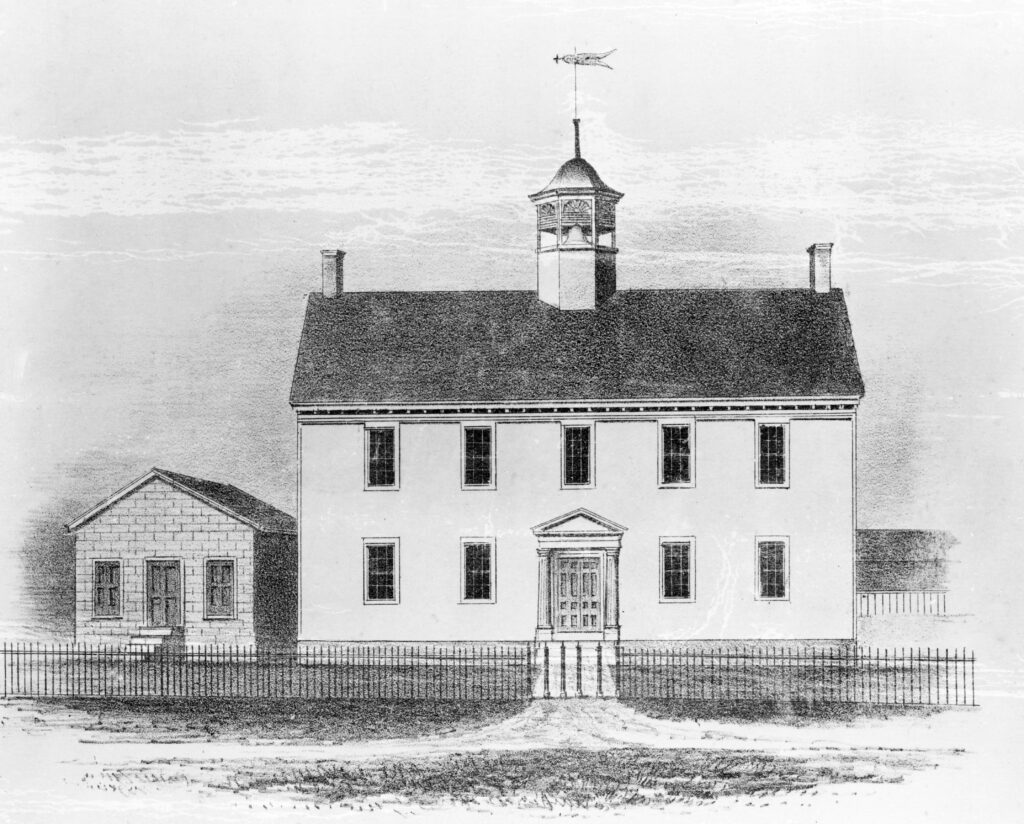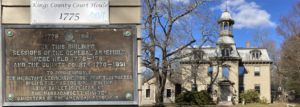
Henry Walling, Cartographer. Map of South Kingstown [Detail – Washington County Courthouse]. Rhode Island 1857. Rhode Island Historical Society, RHi H3 853.
New Court Building
In 1775, Caleb Westcott, who had already demonstrated his talent with the construction of several fine homes in Kingston, was tapped to build a new courthouse, a two-and-a-half-story oak-framed building with side chimneys. The Kings County Court House was a simple barn-like structure with a substantial assembly room on the second floor and a polygonal belfry (see the sketch above). The Rhode Island Colonial Assembly met here in rotation with courthouses in the other counties from 1776 to 1791, and then biennially from 1842 to 1854.
In March 1790 there was high drama in the building, when Henry Marchant (1741-1796) and other Federalists were struggling to get the holdout colony to ratify the U.S. Constitution. Kingston was a favorable environment for the opposition Country Party, but the adoption of several bill-of-rights amendments allowed the Federalists to delay the final vote until a meeting in May in more favorable Newport, where on a vote of 34 to 32 Rhode Island became the thirteenth colony to join the Union. Henry Marchant was a cousin of Juliana Marchant Westcott, quite removed but a cousin nonetheless.
The Kingston Courthouse was radically altered in 1876 with a mansard roof and a central pavilion and tower on top of which the original belfry was mounted. It is now the Kingston Free Library (adapted from Historic and Architectural Resources of South Kingstown).

A Daughters of the American Revolution plaque on the front of the Kingston Free Library notes that the building was originally the Kings County Court House, the structure built by Caleb Westcott in 1775. Click the image for an enlarged view of the building.
A Fourth Good Tavern
Caleb had already expanded Kingston’s ability to host and entertain travel-weary representatives from Providence and other settlements. In 1774 he completed a fourth “good Tavern,” a two-story wood shingled house with a center stone chimney and a portico entrance in a five-bay facade across the street from the village’s first attempt at a courthouse. The building, which Westcott sold in 1783, was used for a tavern until 1890. Today the building is a private residence.

The Westcott Inn/Reynolds Tavern is a long shingled house on Kingstown Road in the center of Kingston. The left (west) end of the building is the original structure built by Caleb Westcott in 1774. In addition to serving as an inn and tavern for much of its history, the building was a stagecoach stop until 1890 (adapted from Historic and Architectural Resources of South Kingstown). Click the photo for an enlarged view of the house
Skilled Carpenter and Patriot
Caleb Westcott was born on December 6, 1716, in Cranston (then part of Providence), the seventh son of Josiah Westcott (1675-1721) and Hannah Gardiner (1680-1756). He was a descendant of Stukely and Juliana Westcott in the fourth generation: Caleb4 Westcott, Josiah3, Jeremiah2, Stukely1.
Caleb’s mother Hannah was a descendant of George Gardiner, who arrived in Rhode Island in 1638 and whose progeny comprised one of the largest families in Colonial Rhode Island. Westcott cousins are well aware of the variations in the spelling of the family name; most frequently the middle “t” disappears and reappears in successive generations, and sometimes it toggles on and off within the records for an individual descendant. The same is true in the Gardiner/Gardner family. An old saw in southern Rhode Island says that there are blind farmers, Gardners without an “i,” and Gardiners with vision.
On May 27, 1739, Caleb Westcott married Hannah Gardiner of Kingston (1723-after 1760), his mother’s cousin once removed. Caleb and Hannah had seven children: Hannah, Abigail, Gardiner, Nicholas, Ruth, Mary and Elizabeth (see Edna Lewis, The Westcott Family Tree, 1999; index number 62).
Caleb may have learned his trade from his father Josiah, who operated a sawmill in Warwick. Caleb and his family lived in various places in Rhode Island including Cranston and Johnston, but they spent most of their time in Kingston, where Hannah’s uncle and wealthy planter Caleb Gardiner and other family members were probably helpful in securing the job to build the new courthouse – always good to know a guy in Rhode Island. Caleb appears on the tax role of the town of South Kingstown (the municipality that includes the village of Kingston) from 1764 to 1797. “Caleb Wescott, carpenter” is listed on the May 1776 muster roles for the Kingston Reds, a militia unit responsible for guarding the south coast against marauding British troops and local Loyalists (referred to as “land pirates”).
Where and when Caleb and Hannah died is not noted in The Westcott Family Tree and there are only contradictory leads in online sources such as Ancestry and Family Search. Caleb may have left Kingston at the end of the 18th century for Newport or Block Island. On May 9, 1785, the South Kingstown Town Council voted “that Caleb Westcot have a Certificate for himself and his Sister [sic] Ruth Westcot & her two children Josiah Westcot & Jeffrey Westcot to the City of Newport acknowledging them Inhabitants of this Town {Certif Given}”.
Caleb and Hannah’s son, Gardiner (1744-1808), and some of his family migrated to Deerfield, New York, in 1793, and then in 1805 moved further north and west to settle in Hounsfield Township in Jefferson County. Caleb and Hannah’s great grandson, Captain George Wellington Westcott (1813-1863), purchased 190 acres along the shore of Lake Ontario south of Sackets Harbor. Today, that property is Westcott Beach State Park.
Sources:
Historic and Architectural Resources of South Kingstown, Rhode Island, Rhode Island Historical Preservation & Heritage Commission reports and publications (RG 050.01), 1984
William H. Jordy et al, contributing editors, Buildings of Rhode Island, 2004.
Edna Lewis, The Westcott Family Tree, 1999 (see index 62).
Christian M. McBurney, A History of Kingston, R.I., 1700-1900, Heart of Rural South County, 2004.
South Kingstown, Rhode Island Town Council Records 1771-1795, Transcribed by Jean C. Stutz, 1988
